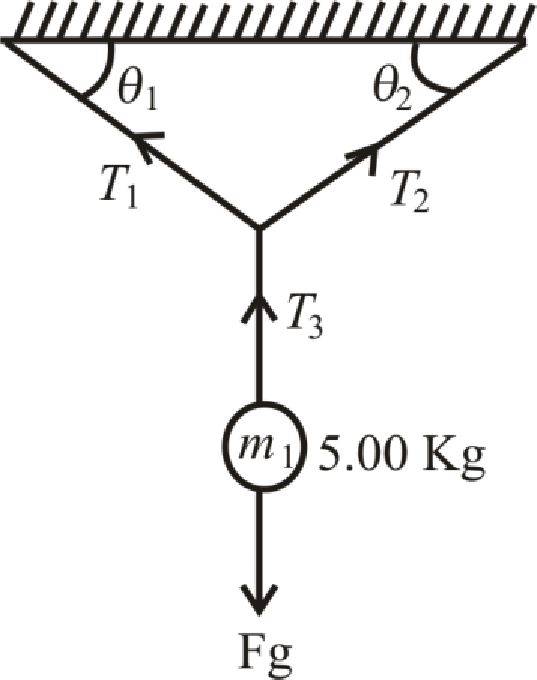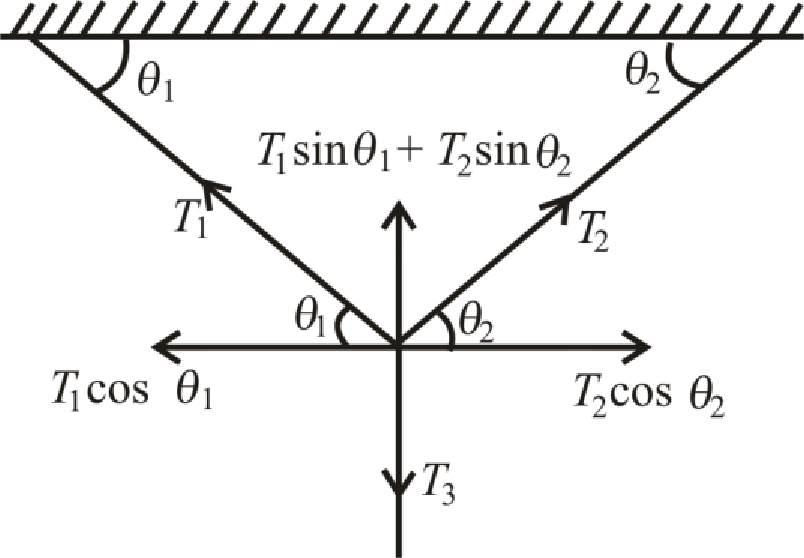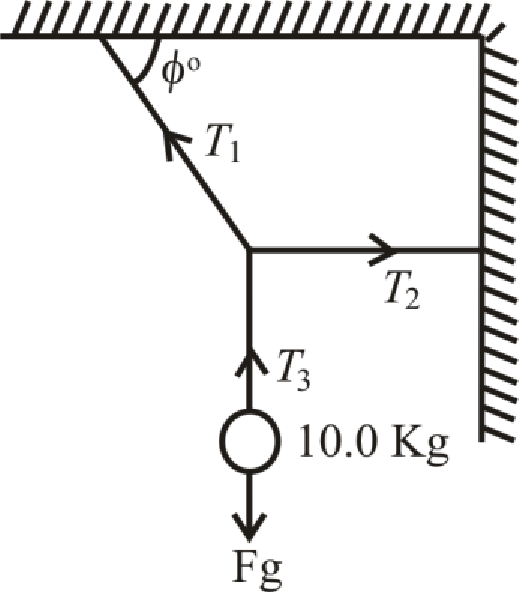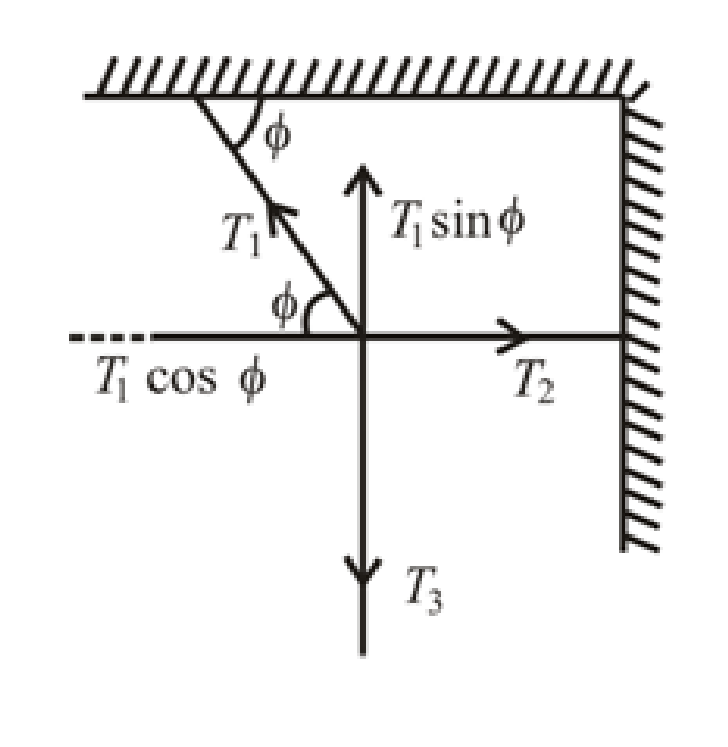
Concept explainers
(a)
The tension in the three strands of the cord.
(a)
Answer to Problem 36P
The tensions in the three strands of the cord are
Explanation of Solution
The tension forces acting on the wires due to the load hanging from the wires is as shown below.

Write the expression for the tension
Here,
The tension force

In static equilibrium the forces acting on the particular point are balanced.
Write the expression for the force balancing in the X-direction as.
Rearrange the above equation for
Here,
Write the expression for the force balancing in Y-direction as.
Substitute
Rearrange the above equation for
Conclusion:
Substitute
Substitute
Substitute
Thus, the tensions in the three strands of the cord are
(b)
The tension in the three strands of the cord.
(b)
Answer to Problem 36P
The tensions in the three strands of the cord are
Explanation of Solution
The tension forces acting on the wires due to the load hanging from the wires is as shown below.

Write the expression for the tension
Here,
The tension force

In static equilibrium the forces acting on the particular point are balanced.
Write the expression for the force balancing in the X-direction as.
Here,
Write the expression for the force balancing in Y-direction as.
Conclusion:
Substitute
Substitute
Substitute
Thus, the tensions in the three strands of the cord are
Want to see more full solutions like this?
Chapter 5 Solutions
Physics For Scientists And Engineers With Modern Physics, 9th Edition, The Ohio State University
- Sucrose is allowed to diffuse along a 12.0-cm length of tubing filled with water. The tube is 6.1 cm² in cross-sectional area. The diffusion coefficient is equal to 5.0 × 10-10 m²/s, and 8.0 × 10−14 x transported along the tube in 18 s. What is the difference in the concentration levels of sucrose at the two ends of the tube? .00567 kg isarrow_forwardneed help part a and barrow_forwardComplete the table below for spherical mirrors indicate if it is convex or concave. Draw the ray diagrams S1 10 30 S1' -20 20 f 15 -5 Marrow_forward
- A particle with a charge of − 5.20 nC is moving in a uniform magnetic field of (B→=−( 1.22 T )k^. The magnetic force on the particle is measured to be(F→=−( 3.50×10−7 N )i^+( 7.60×10−7 N )j^. Calculate the scalar product v→F→. Work the problem out symbolically first, then plug in numbers after you've simplified the symbolic expression.arrow_forwardNeed help wity equilibrium qestionarrow_forwardneed answer asap please thanks youarrow_forward
- A man slides two boxes up a slope. The two boxes A and B have a mass of 75 kg and 50 kg, respectively. (a) Draw the free body diagram (FBD) of the two crates. (b) Determine the tension in the cable that the man must exert to cause imminent movement from rest of the two boxes. Static friction coefficient USA = 0.25 HSB = 0.35 Kinetic friction coefficient HkA = 0.20 HkB = 0.25 M₁ = 75 kg MB = 50 kg P 35° Figure 3 B 200arrow_forwardA golf ball is struck with a velocity of 20 m/s at point A as shown below (Figure 4). (a) Determine the distance "d" and the time of flight from A to B; (b) Determine the magnitude and the direction of the speed at which the ball strikes the ground at B. 10° V₁ = 20m/s 35º Figure 4 d Barrow_forwardThe rectangular loop of wire shown in the figure (Figure 1) has a mass of 0.18 g per centimeter of length and is pivoted about side ab on a frictionless axis. The current in the wire is 8.5 A in the direction shown. Find the magnitude of the magnetic field parallel to the y-axis that will cause the loop to swing up until its plane makes an angle of 30.0 ∘ with the yz-plane. Find the direction of the magnetic field parallel to the y-axis that will cause the loop to swing up until its plane makes an angle of 30.0 ∘ with the yz-plane.arrow_forward
- A particle with a charge of − 5.20 nC is moving in a uniform magnetic field of (B→=−( 1.22 T )k^. The magnetic force on the particle is measured to be (F→=−( 3.50×10−7 N )i^+( 7.60×10−7 N )j^. Calculate the y and z component of the velocity of the particle.arrow_forwardneed answer asap please thank youarrow_forward3. a. Determine the potential difference between points A and B. b. Why does point A have a higher potential energy? Q = +1.0 C 3.2 cm 4.8 cm Aarrow_forward
 Principles of Physics: A Calculus-Based TextPhysicsISBN:9781133104261Author:Raymond A. Serway, John W. JewettPublisher:Cengage Learning
Principles of Physics: A Calculus-Based TextPhysicsISBN:9781133104261Author:Raymond A. Serway, John W. JewettPublisher:Cengage Learning Physics for Scientists and Engineers: Foundations...PhysicsISBN:9781133939146Author:Katz, Debora M.Publisher:Cengage Learning
Physics for Scientists and Engineers: Foundations...PhysicsISBN:9781133939146Author:Katz, Debora M.Publisher:Cengage Learning Physics for Scientists and Engineers with Modern ...PhysicsISBN:9781337553292Author:Raymond A. Serway, John W. JewettPublisher:Cengage Learning
Physics for Scientists and Engineers with Modern ...PhysicsISBN:9781337553292Author:Raymond A. Serway, John W. JewettPublisher:Cengage Learning Physics for Scientists and EngineersPhysicsISBN:9781337553278Author:Raymond A. Serway, John W. JewettPublisher:Cengage Learning
Physics for Scientists and EngineersPhysicsISBN:9781337553278Author:Raymond A. Serway, John W. JewettPublisher:Cengage Learning College PhysicsPhysicsISBN:9781285737027Author:Raymond A. Serway, Chris VuillePublisher:Cengage Learning
College PhysicsPhysicsISBN:9781285737027Author:Raymond A. Serway, Chris VuillePublisher:Cengage Learning University Physics Volume 1PhysicsISBN:9781938168277Author:William Moebs, Samuel J. Ling, Jeff SannyPublisher:OpenStax - Rice University
University Physics Volume 1PhysicsISBN:9781938168277Author:William Moebs, Samuel J. Ling, Jeff SannyPublisher:OpenStax - Rice University





